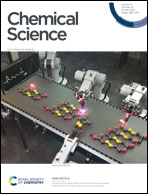Direct and quantitative monitoring of catalytic organic reactions under heterogeneous conditions using direct analysis in real time mass spectrometry†
Abstract
This new method overcomes problems of conventional analytical methodologies such as light scattering and sampling reproducibility issues. We used this method for mechanistic studies of catalytic reactions under heterogeneous conditions. Direct-type hydroxymethylation reactions and Mukaiyama-type hydroxymethylation reactions both catalyzed by a scandium–bipyridine ligand complex under micellar conditions were employed as examples of heterogeneous reactions. For direct-type hydroxymethylation reactions, initial reaction rate assays revealed first-order dependency on both substrate and catalyst. On the other hand, Mukaiyama-type hydroxymethylation reactions showed first-order rate dependency on substrate, zero-order on catalyst and saturation kinetics on formaldehyde.



 Please wait while we load your content...
Please wait while we load your content...